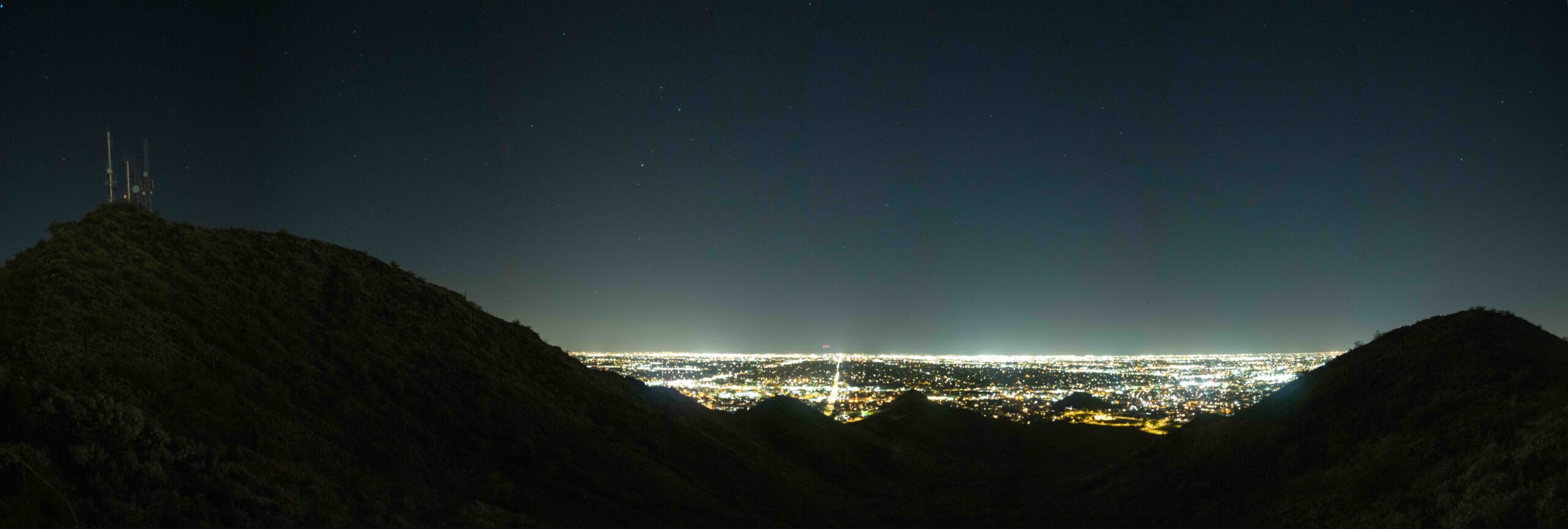
Light pollution over Pheonix, Arizona
I’m looking straight up into the night sky and I can only see a few stars. I know there are billions of stars out there and thousands that I can see with my naked eye. But right now it’s only those three or four.
I’m standing next to my car in Provo, Utah and almost everything I own is in the car. Four hours ago I moved out of Torrey, Utah, an International Dark Sky certified town of 180 people.
When I stood outside my trailer in Torrey and looked straight ahead at the horizon I could see more stars than I could see now. In Torrey, I was hard-pressed to not stop and gape at the heavens every time I walked to the bathroom at night.
I’m looking at those few stars above my head. I’m thinking of where I’ve just left and where I’m moving to—a metropolitan area of millions of people. I’m thinking of the next time I might get to really see the night sky again. And I’m filled with sorrow because I may never again have a home with a night sky like Torrey.
Dark Skies Are Disappearing
It’s hard to recognize how much light pollution is around us until we’ve been somewhere without it. I think the real “a-ha” moment for me in regards to light pollution happened somewhere along US highway 180 about 200 miles north of Pheonix and 16 miles south of the Grand Canyon. I had pulled over on BLM land and was planning to take some photos of the night sky.
Unsurprisingly, the night sky was amazing. There were thousands of stars. But something was off. Looking south there was a glow in the sky from Phoenix, some 200-miles-away. Looking southeast I could also see the glow of Flagstaff. It was shocking and somewhat disappointing. Here I thought I had left the city and its light behind.
It turns out though that leaving artificial lights behind is harder than you would expect. A staggering 99% of US citizens and 80% of all humans worldwide live in areas with light-polluted skies. 80% of North Americans can’t even see the Milkyway.
More Than Just the Stars
Light pollution goes way beyond just making it harder to enjoy the night sky though. Studies have shown that human health is negatively affected by artificial light—it can lead to increased “risks for obesity, depression, sleep disorders, diabetes, breast cancer and more.”
Light pollution is terrible for ecosystems too. Migratory birds are massively affected when they run into buildings and windows. Lighting disturbs amphibians in wetlands. Butterflies and other insects collide with lights and perish. Perhaps most heart wrenching of all—baby sea turtles die after hatching when they run towards lights instead of the ocean.
Artificial lights also hit our pockets. In the US alone, excess and waisted light can cost $3 billion a year. To add insult to injury outdoor lighting has not been shown to reduce crime and can even increase crime rates.
In short, light pollution is a lose-lose for every living thing involved.
Get Inspired
The good news is that you can help!
Have you ever experienced a truly dark sky? It’s an amazing experience that I highly recommend. Check out one of the dozens of International Dark Sky Parks to get some first-hand exposure.
Staying the night at a dark sky park is an amazing way to experience national parks in a new way. One of my favorite national park slogans is “Half the Park is After Dark.” And I couldn’t agree more!
Many national parks will have night sky themed ranger talks and “star parties.” Bryce Canyon and Craters of the Moon are well known for their astronomy and night sky programs
Experience the Night Sky

The Milky Way as seen from the Selway River in Idaho
When I worked at a scout camp in the Tetons I spent hours just staring at the night sky. It was mind-blowing. I would walk to my tent at night and risk tripping over rocks for staring straight up.
My hope is that everyone gets to have experiences like that. That everyone can slow down in a light-pollution-free area and wonder at nature’s homemade fairy lights. As cities grow, I hope we’re more careful where we put our lights so we can live in harmony with the natural world around us. And everyone can make a difference right now.
Make a Difference
Each of us can take steps towards making the world less light-polluted. Close your blinds at night, install dark sky friendly lighting around your home, advocate for a light ordinance in your home town, and spread the word. No small effort is wasted. You may even help create the next dark sky community.
The International Dark Sky Association has a list of ways you can take action now.
Moving Forward
It’s been almost two years since I was standing in that parking lot in Provo. I still live in a suburban area with heavy light pollution and that’s hard for me. But I’ve still been able to visit truly dark skies several times over the last few years. My time in Torrey left a lasting impression on me though, and I look back on it fondly. It helped shape my future. And every night I’m happy to close my curtains and help protect my little patch of sky.
Do you have an experience slowing down and seeing the night sky? We’d love to hear about it! Leave a comment, send us an email, or share your experience on Instagram with the hashtag #slowtheparks
Additional Resources
- See how light-polluted your home town is with this interactive map.
- In 2017, after years of work Ketchum Idaho was able to be certified a Dark Sky Community, and the Central Idaho Dark Sky Reserve was formed.
